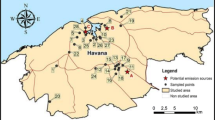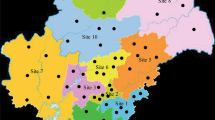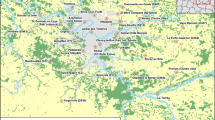Abstract
The concentrations and composition of persistent organic pollutants (POPs) were determined in alluvial soils subjected to heavy flooding in a rural region of Poland. Soil samples (n = 30) were collected from the upper soil layer from a 70-km2 area. Chemical determinations included basic physicochemical properties and the contents of polychlorinated biphenyls (PCBs), hexachlorocyclohexanes (HCHs), dichlorodiphenyltrichloroethanes (DDTs) and polycyclic aromatic hydrocarbons (PAHs, 16 compounds). The median concentrations of Σ7PCB (PCB28 + PCB52 + PCB101 + PCB118 + PCB138 + PCB153 + PCB180), Σ3HCH (α-HCH + β-HCH + γ-HCH) and Σ3pp′(DDT + DDE + DDD) were 1.60 ± 1.03, 0.22 ± 0.13 and 25.18 ± 82.70 μg kg−1, respectively. The median concentrations of the most abundant PAHs, phenanthrene, fluoranthene, pyrene, benzo[b]fluoranthene and benzo[a]pyrene were 50 ± 37, 38 ± 27, 29 ± 30, 45 ± 36 and 24 ± 22 μg kg−1, respectively. Compared with elsewhere in the world, the overall level of contamination with POPs was low and similar to the levels in agricultural soils from neighbouring countries, except for benzo[a]pyrene and DDT. There was no evidence that flooding affected the levels of POPs in the studied soils. The patterns observed for PAHs and PCBs indicate that atmospheric deposition is the most important long-term source of these contaminants. DDTs were the dominant organochlorine pesticides (up to 99 %), and the contribution of the parent pp′ isomer was up to 50 % of the ΣDDT, which indicates the advantage of aged contamination. A high pp′DDE/pp′DDD ratio suggests the prevalence of aerobic transformations of parent DDT. Dominance of the γ isomer in the HCHs implies historical use of lindane in the area. The effect of soil properties on the POP concentrations was rather weak, although statistically significant links with the content of the <0.02-mm fraction, Ctotal or Ntotal were observed for some individual compounds in the PCB group.





Similar content being viewed by others
References
Armitage, J. M., Hanson, M., Axelman, J., & Cousins, I. T. (2006). Level and vertical distribution of PCBs in agricultural and natural soils from Sweden. Science of the Total Environment, 371, 344–352.
Baczyński, T. P., Pleissner, D., & Grotenhuis, T. (2010). Anaerobic biodegradation of organochlorine pesticides in contaminated soil—significance of temperature and availability. Chemosphere, 78, 22–28.
Bojakowska, I., & Gliwicz, T. (2005). Chlorinated pesticides and polychlorinated biphenyls in river sediments of Poland. Przegląd Geologiczny, 53, 649–655 (in Polish).
Cai, Q., Mo, C., Wu, Q., Katsoyiannis, A., & Zeng, Q. (2008). The status of soil contamination by semivolatile organic chemicals (SVOCs) in China: a review. Science of the Total Environment, 389, 209–224.
Carlon, C., D’Alessandro, M., & Swartjes, F. (2007). Derivation methods of soil screening values in Europe. A review and evaluation of national procedures towards harmonisation. In: Carlon C. (Ed). JRC Scientific and Technical Report EUR 22805 EN–2007. Luxemburg: Office for Official Publications of the European Communities
Desaules, A., Ammann, S., Blum, F., Brändli, R. C., Bucheli, T. D., & Keller, A. (2008). PAH and PCB in soils of Switzerland—status and critical review. Journal of Environmental Monitoring, 10, 1265–1277.
Dz. U. 02.165.1359, 2002. Rozporządzenie Ministra Środowiska z dnia 9 września 2002 r w sprawie standardów jakości gleby oraz standardów jakości ziemi (in Polish).
Elhottová, D., Krištůfek, V., Třiska, J., Chrastný, V., Uhliřová, E., Kalčik, J., & Picek, T. (2006). Immediate impact of the flood (Bohemia, August 2002) on selected soil characteristics. Water, Air, and Soil Pollution, 173, 177–193.
Environment Canada (1998). Canadian Soil Quality Guidelines for the Protection of Environmental and Human Heath
Eulenstein, F., Műller, L., & Helming, K. (1998). Odra 1997 flood effects on soil properties of cultivated areas in Germany. International Agrophysics, 12, 241–247.
Falandysz, J., & Szymczyk, K. (2001). Data on the manufacture, use, inventory and disposal of polychlorinated biphenyls (PCBs) in Poland. Polish Journal of Environmental Studies, 10(3), 189–193.
Falandysz, J., Brudnowska, B., Kawano, M., & Wakimoto, T. (2001). Polychlorinated biphenyls and organochlorine pesticides in soils from southern part of Poland. Archives of Environmental Contamination and Toxicology, 40, 173–178.
Franzle, O., Krinitz, J., Schmotz, W., Delschen, T., & Leisner-Saaber, J. (1996). Harmonization of investigation methods and evaluation for risk assessment in soil protection with Russian Federation. Report. In: Terytze, K. (eds). UBA-FB 95–048. Umweltbundesamt, Berlin.
Gao, J., Zhou, H., Pan, G., Wang, J., & Chen, B. (2013). Factors influencing the persistence of organochlorine pesticides in surface soil from the region around Hangze Lake, China. Science of the Total Environment, 443, 7–13.
Gusev, A., Mantseva, E., Rozovskaya, O., Shatalov, V., Sokovyh, V., Aas, W., et al. (2009). Persistent organic pollutants in the environment. EMEP Status Report 3/2009.
Hilscherova, K., Dušek, L., Kubik, V., Čupr, P., Hofman, J., Klánová, J., & Holoubek, I. (2007). Redistribution of organic pollutants in river sediments and alluvial soils related to major floods. Journal of Soils and Sediments, 7(3), 167–177.
Holoubek, I., Klánová, J., Jarkovskỳ, J., Kubik, V., & Helesic, J. (2007). Trends in background levels of persistent organic pollutants at Kosetice observatory, Czech Republic. Part II. Aquatic and terrestrial environments 1996–2005. Journal of Environmental Monitoring, 9, 564–571.
Holoubek, I., Dušek, L., Sáňka, M., Hofman, J., Čupr, P., Jarkovskỳ, J., Zbíral, J., & Klánová, J. (2009). Soil burdens of persistent organic pollutants—their levels, fate and risk. Part I. Variation of concentration ranges according to different soil uses and locations. Environmental Pollution, 157(12), 3207–3217.
ISO 10382 (2002). Soil quality—determination of organochlorine pesticides and polychlorinated biphenyls—gas-chromatographic method with electron capture detection. Geneva: International Standardization Organization
ISO 10390 (2005). Soil quality—determination of pH. Geneva: International Standardization Organization
ISO 18287 (2006). Soil quality—determination of polycyclic aromatic hydrocarbons (PAH)—gas chromatographic method with mass spectrometric detection (GC-MS). Geneva: International Standardization Organization
ISO 22892 (2006). Soil quality—guidelines for the identification of target compounds by gas chromatography. Geneva: International Standardization Organization
Kawano, M., Brudnowska, B., Falandysz, J., & Wakimoto, T. (2000). Polychlorinated biphenyls and organochlorine pesticides in soils in Poland. Roczniki Panstwowego Zakladu Higieny, 51(1), 15–28 (in Polish).
Klimkowicz-Pawlas, A., Maliszewska-Kordybach, B., & Smreczak, B. (2012). Application of preliminary stage of risk assessment procedure for agricultural soils: area affected by flood as a case study. Journal of Food Agriculture and Environment, 10(1), 675–680.
Kukučka, P., Klánová, J., Sáňka, M., & Holoubek, I. (2009). Soil burdens of persistent organic pollutants—their levels, fate and risk. Part II. Are there any trends in PCDD/F levels in mountain soils? Environmental Pollution, 157(12), 3255–3263.
Lityński, T., Jurkowska, H., & Gorlach, E. (1972). Gleba i nawozy. Warszawa, pp. 89–97 (in Polish)
Maliszewska-Kordybach, B., Smreczak, B., Klimkowicz-Pawlas, A., & Terelak, H. (2008). Monitoring of the total content of polycyclic aromatic hydrocarbons (PAHs) in arable soils in Poland. Chemosphere, 73, 1284–1291.
Maliszewska-Kordybach, B., Smreczak, B., & Klimkowicz-Pawlas, A. (2009). Concentrations, sources and spatial distribution of individual polycyclic aromatic hydrocarbons (PAHs) in agricultural soils in the Eastern part of the EU; Poland as a case study. Science of the Total Environment, 407, 3746–3753.
Maliszewska-Kordybach, B., Klimkowicz-Pawlas, A., Smreczak, B., & Stuczyński, T. (2010). Relationship between soil concentrations of PAHs and their regional emission indices. Water, Air, and Soil Pollution, 213, 319–330.
Maliszewska-Kordybach, B., Klimkowicz-Pawlas, A., Smreczak, B., & Gałązka, R. (2012). Effect of flooding on contamination of agriculture soils with metals and PAHs: The Middle Vistula Gap Case Study. Water, Air, and Soil Pollution, 223, 687–697.
Manz, M., Wenzel, D., Dietze, U., & Schuurmann, G. (2001). Persistent organic pollutants in agricultural soils of central Germany. Science of the Total Environment, 277, 187–189.
Nam, J. J., Thomas, G. O., Jaward, F. M., Steinnes, E., Gustafsson, O., & Jones, K. C. (2008a). PAHs in background soils from Western Europe: influence of atmospheric deposition and soil organic matter. Chemosphere, 70, 1596–1602.
Nam, J. J., Gustafsson, O., Kurt-Karakus, P., Breivik, K., Steinnes, E., & Jones, K. C. (2008b). Relationship between organic matter, black carbon and persistent organic pollutants in European background soils: implication of sources and environmental fate. Environmental Pollution, 156, 809–817.
PN-R-04032 (1998). Soils and mineral soils materials. Soil sampling and determination of particle size distribution in mineral soil material. Warsaw: Polish Committee for Standardization (in Polish)
Pulkrabová, J., Suchanová, M., Tomaniová, M., Kocourek, V., & Hajšlová, J. (2008). Organic pollutants in area impacted by flooding in 2002: a 4-year survey. Bulletin of Environmental Contamination and Toxicology, 81, 299–304.
Škrbič, B., & Durišić-Mladenović, N. (2007). Principal component analysis for soil contamination with organochlorine compounds. Chemosphere, 69, 2144–2152.
Smreczak, B., Klimkowicz-Pawlas, A., & Maliszewska-Kordybach, B. (2011). Persistent organic pollutants (POPs) in agricultural soils of Lubelskie voivodeship. In: Mat. of International Conference “Agrophysics for the Quality of Life” 31.05-3.06. 2011, Lublin, Poland
Stachel, B., Christoph, E. H., Gőtz, R., Herrmann, T., Krűger, F., Kűhn, T., Lay, J., Loffler, J., Papke, O., Reincke, H., Schroter-Kermani, C., Schwarz, R., Steeg, E., Stehr, D., Uhli, S., & Umlaut, G. (2006). Contamination of the alluvial plain, feeding stuffs and foodstuffs with polychlorinated dibenzo-p-dioxins, polychlorinated dibenzofurans (PCDD/Fs), dioxin-like polychlorinated biphenyls (DL-PCBs) and mercury from river Elbe in the light of the flood event in August 2002. Science of the Total Environment, 364, 96–112.
Terelak, H., Stuczynski, T., Motowicka-Terelak, T., Maliszewska-Kordybach, B., & Cz, P. (2008). Monitoring of the chemical properties of arable soils in Poland in years 2005–2007 (p. 135). Warszawa: Biblioteka Monitoringu Srodowiska. (in Polish).
Vácha, R., Polaček, O., & Horváthová, V. (2003). State of contamination of agricultural soils after floods in August 2002. Plant, Soil and Environment, 449(7), 307–313.
Walker, C. H. (2009). Organic pollutants. An ecotoxicological perspective. Boca Raton: CRC.
Wang, H., He, M., Lin, C., Quan, X., Guo, W., & Yang, Z. (2007). Monitoring and assessment of persistent organochlorine residues in sediments from Daliaohe river watershed. Northeast China. Environmental Monitoring and Assessment, 133, 231–242.
Weber, J., Drozd, J., & Licznar, M. (1998). Characteristic of soils subjected to flood in July 1997 at the region of Lubsza community—situation after 5 months. International Agrophysics, 12, 249–257.
Wyrzykowska, B., Bochentin, I., Hanari, N., Orlikowska, A., Falandysz, J., Horii, Y., & Yamashita, N. (2006). Source determination of highly chlorinated biphenyl isomers in pine needles—comparison to several PCB preparations. Environmental Pollution, 143, 46–59.
Wyrzykowska, B., Hanari, N., Orlikowska, A., Bochentin, I., Rostkowski, P., Falandysz, J., Taniyasu, S., Horii, Y., Jiang, Q., & Yamashita, N. (2007). Polychlorinated biphenyls and naphthalenes in pine needles and soil from Poland—concentrations and patterns in the view of the long-term environmental monitoring. Chemosphere, 67, 1877–1886.
Wyrzykowska, B., Hanari, N., Orlikowska, A., Yamashita, N., & Falandysz, J. (2009). Dioxin-like compositional profiles of furnace bottom ashes from household combustion in Poland and their possible associations with contamination status of agricultural soil and pine needles. Chemosphere, 76, 255–263.
Acknowledgments
Financial support from the NCN grant no. UMO-2011/03/B/ST10/0515 “The role of soil properties in the processes of accumulation of persistent organic contaminants” and the IUNG-PIB programme 1.2 “Assessment of threats to soil environment and mitigation of degradation effects in rural areas” is kindly acknowledged.
Author information
Authors and Affiliations
Corresponding author
Rights and permissions
About this article
Cite this article
Maliszewska-Kordybach, B., Smreczak, B. & Klimkowicz-Pawlas, A. The levels and composition of persistent organic pollutants in alluvial agriculture soils affected by flooding. Environ Monit Assess 185, 9935–9948 (2013). https://doi.org/10.1007/s10661-013-3303-3
Received:
Accepted:
Published:
Issue Date:
DOI: https://doi.org/10.1007/s10661-013-3303-3




